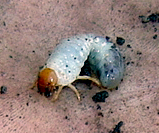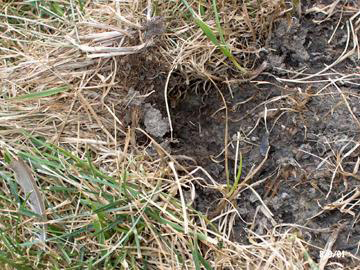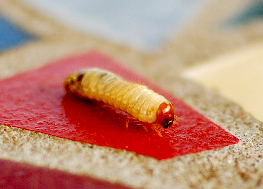Grub Control: How to get rid of grubs in the lawn
Return to Insect Agent Articles

Grubs are one of the areas most common and destructive lawn pests. They cause the lawn to decline or die out in late summer and early fall. Grubs feed on the roots of healthy grass, limiting the plant’s ability to uptake water and nutrients. The most common turf species in our area, tall fescue and bluegrass, are both potentially affected.
 Damage is most severe in the sunny parts of the lawn. Highly maintained lawns, those watered regularly during the summer, are more likely to suffer damage than low input turf. Controlling grubs before they cause the below ground damage is often a challenge and confusing. Success in controlling grubs is a combination of knowing the grub’s habit and proper chemical selection and application.
Damage is most severe in the sunny parts of the lawn. Highly maintained lawns, those watered regularly during the summer, are more likely to suffer damage than low input turf. Controlling grubs before they cause the below ground damage is often a challenge and confusing. Success in controlling grubs is a combination of knowing the grub’s habit and proper chemical selection and application.
Identifying grubs and their life cycle

Grubs are the white C-shaped larvae of several types of beetles including June bugs and southern masked chafer. These ravenous feeders can be found almost year-round. In fact, finding a few grubs can be a sign of healthy soil.
The most common grub species is the southern masked chafer, which has a very predictable life cycle. Understanding that cycle aids in proper control strategies:
- Adults lay eggs in the lawn during early to mid-summer.
- These eggs hatch in mid-August and start to feed. It is this feeding period that damages the lawn.
- Winter’s arrival forces the grubs deep into the soil.
- Come spring they move back to the soil surface and prepare to emerge, starting the cycle over.
Controlling grubs
Controlling grubs requires the use of chemicals. There are no reliable organic controls for the species of grubs found in this part of the country. Grub control can be confusing, as there are two approaches:
- Preventive, or
- Rescue treatments.
Preventive treatments are applied from mid-June through early July for the best results. These products have long residuals and control grubs, as they ingest the chemicals when feeding begins in August. Examples of preventive treatments include,
- Imidacloprid
- Chlorantraniprole
Rescue treatments are applied as the grubs are hatching in mid August. The product that provide the best control is
- Trichlorfon
Timing application for best grub control results
Either method can provide good results if properly applied and at the correct time. Many people prefer the preventive treatment because of convenience. It can be applied over a longer period making timing less critical. The only disadvantage of preventive treatments is a higher cost. Preventive treatments are generally safer for the environment and non-target organisms.
Follow label instructions
No matter what product is used, be sure to read and follow all label instructions. For the products to be effective they must be watered into the soil within a day or so. Chemicals not watered into the soil quickly breakdown under the sunlight and become less or ineffective. That means your control is poor.
Grubs, being a below ground pest, make it difficult to know whether or not they are present. As a rule of thumb, if grubs infested your lawn in past years they will probably be back. Be prepared to take control before your spring lush growth becomes a pasty shade of summer dead.

